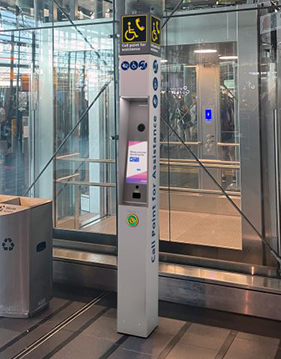Schiphol’s all new PRM call points
As global demographics shift towards an older population, the challenge of accommodating Persons with Reduced Mobility (PRM) is becoming increasingly important. With the European Accessibility Act setting new standards for accessibility and Schiphol's commitment to ensure a seamless travel experience for all, the airport introduces an innovative and future-proof solution: the all-new PRM call points.
In short:
- In 2024, Schiphol is rolling out new PRM call points, enhancing airport accessibility ahead of the European Accessibility Act, focusing on innovation and efficiency.
- Responding to an aging population and new EU accessibility laws, Schiphol aims to set benchmarks for airport service inclusivity.
- Featuring optional video calls, touchscreens, and barcode scanners, Schiphol's PRM call points improve communication and support for PRM passengers.
This innovation not only aims to surpass regulatory compliance but also introduces a new era of care, convenience, and efficiency in airport PRM services. How can airports adapt to the growing needs of PRM passengers while enhancing operational effectiveness? Schiphol's all-new PRM call points offer an answer, setting a benchmark for the future of accessible travel.

Mockup of the PRM call points,
to become available in 2024
The growing need for PRM support
In a time characterised by an ageing global population, the aviation industry faces a significant increase in PRM passengers. The United Nations' World Population Prospects 2022 report underscores a trend that is hard to ignore: by 2050, nearly 16 percent of the global population will be over the age of 65, up from approximately 10 percent in 2022.
There is a strong correlation between age and disability, which means that airports will see a substantial rise in PRM passengers. Currently, PRM passengers represent between 1% and 2% of all travellers, but this number is expected to grow rapidly. Disabilities, predominantly related to mobility, sight, and hearing, become more prevalent with age, presenting an increasing challenge for airports worldwide.
Tijn Borms is Product Director of Schiphol’s Passenger Experience Platform and emphasises the urgency of the situation: "Scaling the population numbers linearly would mean the cost of the PRM process at airports will almost double by 2050, so doing nothing is not a viable option."
The legislative landscape is changing
The evolving legislative landscape underscores the need for innovative PRM solutions. The European Accessibility Act mandates that by 28 June 2025, all new products and services in EU member states, including digital information services and physical terminals like self-service kiosks, ATMs, and PRM call points, must be universally accessible.
While this act specifically targets new developments, it serves as a significant prompt for airports to consider the accessibility of their existing systems. Although there is no immediate legal requirement to overhaul current systems, doing so could ensure future compliance and demonstrate a proactive commitment to inclusivity.
Similarly, in the United States, the Americans with Disabilities Act (ADA) has set precedents for accessibility that impact global aviation standards. Most existing PRM and kiosk solutions fall short of these evolving requirements, signalling a clear need for a forward-thinking approach to PRM support that not only meets but exceeds legislative expectations.
Schiphol believes that the growing need for PRM support and the changing legislative landscape poses a few challenges, but that it is also a great opportunity to enhance the overall passenger experience and improve the operational process.
Schiphol's innovative PRM solution
Schiphol Airport has developed the new PRM call points to address the needs of PRM passengers, aligning with its commitment to accessible travel for all. This system integrates advanced technology with practical design elements to improve the airport experience for PRM passengers.
The PRM call points consist of two components: a web application and durable hardware. The web application is designed to facilitate communication between PRM passengers and support agents, aiming for responsive and tailored assistance. Drawing from the experience with Schiphol’s Self-Service Units (SSUs), the hardware is constructed for both functionality and longevity.
The call points feature a 12” multi-touch screen, providing an interface that is accessible and user-friendly. To cater to a range of needs, it includes a hearing loop for passengers with hearing aids and a screen reader for those with visual impairments. Additionally, a barcode scanner is integrated for efficient document processing. Encased in stainless steel, the call points are robustly designed to be suitable for both indoor and outdoor environments.
A significant aspect of the PRM call points is its optional video call function, enabling live, two-way audio-visual communication, similar in nature to FaceTime. This feature is facilitated through a built-in camera, microphone, and speaker. Importantly, it includes a physical call button, designed for ease of use by people who may not be able to operate a touchscreen or have limited vision. Additionally, the PRM call points offer a chat function, providing an alternative text-based communication option for passengers who prefer or require it.
These capabilities ensure clear, direct communication between passengers and support agents, enhancing the support process through both real-time interaction and accessible text communication.
Enhancing passenger experience
As a PRM Service Manager, Lot Defoort is responsible for the journey experience of Schiphol’s PRM passengers. She applauds the addition of video calling to the PRM call points.
Although Schiphol will initially go live without the video-call feature turned on until the support staff is properly onboarded, speaking face-to-face with someone can make a huge difference, she notes. "Just think about why we enjoy using FaceTime so much – it's far more engaging to have a conversation with someone you can see." She believes that from a standpoint of equality, using this feature will be a significant step forward: "Persons without reduced mobility also engage in direct conversations with staff when they arrive at the airport and check in their bags, so why not PRM?"
The integration of a barcode scanner for boarding passes in the PRM call points also significantly enriches the passenger experience. As Defoort explains, this technology streamlines the usual time-consuming process of communicating travel information. With essential details instantly accessible, staff can focus more on engaging personally with passengers. Inquiring about their excitement for the trip, addressing any specific needs they might have, or assisting them with information about airport facilities, like locating stores, adds a personal dimension to their journey. These interactions, Defoort emphasises, are not just procedural necessities but crucial elements that enhance the overall travel experience.
Operational advantages for airports
Wen Cheung, overseeing the operational process for PRM passengers at the airport, shares the enthusiasm for the new PRM call points, especially its integrated barcode scanner. He points out that in an international hub like the airport, where language barriers are common, manual entry of passenger details is often error-prone. "With the growing number of PRM passengers and the challenges of a tight labour market, automating this part of the process is a game changer", he says. This automation will allow us to provide a better service to our passengers.
Under Cheung's guidance, the airport has been striving to become a leader in PRM services. "This year is pivotal for us," he remarks. "Our goal is to rank among the top 10 most accessible airports globally and gain recognition for our efforts. The new PRM call points are a key part of this ambition. It reflects our commitment to entrepreneurship and continuous innovation in providing the best possible experience for all passengers. During the development Schiphol has closely collaborated with the Airport User Committee, a committee of representatives of airport users and organisations."
Schiphol expects the roll-out to happen in de second half of the year.

Mockup of the PRM call points,
to become available in 2024
Continuous improvement and future developments
Looking towards the future, Schiphol’s PRM module stands as a dynamic product, constantly evolving much like any other app in today's digital age. It's not just a static tool but a platform for ongoing innovation and enhancement.
Key among the planned improvements is the integration of real-time captions for video calls, a feature designed to significantly aid PRM passengers with hearing disabilities. This development is another important step towards inclusive communication.
Schiphol also aims to introduce a pre-registration widget on its airport websites. This addition is set to streamline the process significantly, allowing passengers to enter their details beforehand, thereby enabling support agents to provide more tailored and efficient assistance upon the passenger's arrival.
Further enhancing operational efficiency, the module can be integrated with airline messaging systems. This integration aims to automate the information matching process, making the handling of passenger data smoother and more accurate.
The development of 'move-to-mobile' functionality is another innovative step forward. This feature will enable PRM passengers to maintain seamless communication with their support agents, ensuring continuous assistance and a smoother travel experience (read an earlier interview about the mobile features of the Passenger Experience Platform here.
Explore Schiphol’s PRM call points further
Airports considering enhancing their facilities for PRM Passengers can leverage Schiphol’s new PRM call points. Schiphol Group Aviation Solutions makes it possible for other airports to implement and use the same system and benefit from shared developments. They can connect with Gertjan Bluemink directly or by requesting a demo by filling in this form for an in-depth demonstration of the possibilities.
Read the previous blogs
-
The Amsterdam Delay Allocation Method explained
Published on:Here’s how airports can improve delay insights by using already available data to get a deep understanding of the delay breakdown, enabling improvements.

-
Menzies’ 365 days with Deep Turnaround
Published on:Menzies Aviation shares their insights on how they transformed airport efficiency and communication with Schiphol's Deep Turnaround system over the past year.

-
Deep Turnaround featured on Future Airport
Published on:Future Airport's feature highlights Schiphol and Eindhoven Airport for their adoption of Deep Turnaround tech, revolutionizing airport operations.
